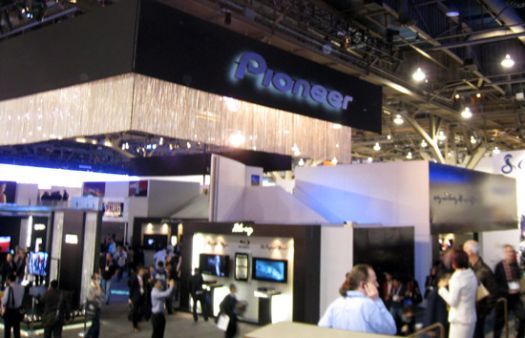Pioneer's KURO Plasma HDTV Prototypes - Black is Back and Thin is In
By Chris Boylan
Black is Back and Thin is In!
At CES every year, there's always at least one or two things that make you go "WOW!" And this year two of those wows come courtesy of Pioneer's new prototype plasma HDTVs. Both are 50-inch models: one is 9mm thick (yes that's less than 4/10 of an inch), which makes it thinner than most cell phones, and the other prototype plasma panel has the deepest, darkest blacks I have ever seen on a television, regardless of technology.
The 9mm panel a.k.a. "Advanced Design Concept" was impressive, weighing in at just 41 pounds. Since plasma is a self-emissive technology (each pixel or "cell" illuminates itself with no backlighting required), and traditional LCD televisions require a backlight, it's possible to make a plasma panel thinner than even the slimmest LCD panel. But squeezing one all the way down to 9 millimeters is previously unheard of and creates a display that literally seems to just float on the wall rather than hang from it. Pioneer had a working prototype on display but no specific pricing or availability estimates.

Pioneer's booth at CES was abuzz with activity and interest in their latest advancements in plasma technology.

Thin is in!
Also on functional display was a second new prototype plasma - the "Extreme Contrast Concept." Pioneer says this display will "render the contrast discussion moot" as the new technology allows them to make a plasma cell completely non-emissive. This "infinite blackness" makes the contrast immeasurable, hence beyond comparison. Rather than the standard emissions that normally occur in a plasma pixel when it's powered by an electrical charge (which give even the best plasma panels a dark grey hue in place of true black), Pioneer says they have found a way to make plasma technology become non-emissive, producing a complete absence of light or color when necessary.
And I have to say the demonstration brought this point home. They began the demo in near complete darkness in a simulated home theater environment. On display were three of Pioneer's current model, the PDP-5010HD - already a reference for contrast and black levels in the television industry. Although the black levels of this set are impressive, in the full darkness of the demo room, you could easily make out the rectangular boundaries of the screen.
The demo switched to just one of the PDP-5010 panels (in the front of the room) which began running a demo clip. And then without warning the same demo clip - a spinning golden ring on a black background - magically appeared about 5 feet away from the primary TV, seemingly floating in space. There was literally no evidence of a screen - no visible outline where the dark grey collided with the inky blackness of the surrounding air. Although this may have been a flat, two-dimensional image, the ring appeared to be floating in three-dimensional space, and as the demo progressed through a range of materials and colors, the illusion persisted.
On cinemascope aspect ratio source material (2.4:1), the black letterbox bars at the top and bottom of the image which were faint yet clearly visible on the PDP-5010 were completely invisible on the new panel, blending seamlessly with the deep black darkness beyond the screen. I've seen a lot of television demos, but this one easily elicited the most audible reactions, e.g., "wow!" "Ohmigod!" and even "holy sh*t!"
As impressive as Pioneer's current production televisions may be, this new technology brings picture quality to the next level. Start saving your pennies now, HDTV fans, because one thing's certain - when this technology does become available in a consumer model, this little slice of deep dark perfection won't come cheap!

